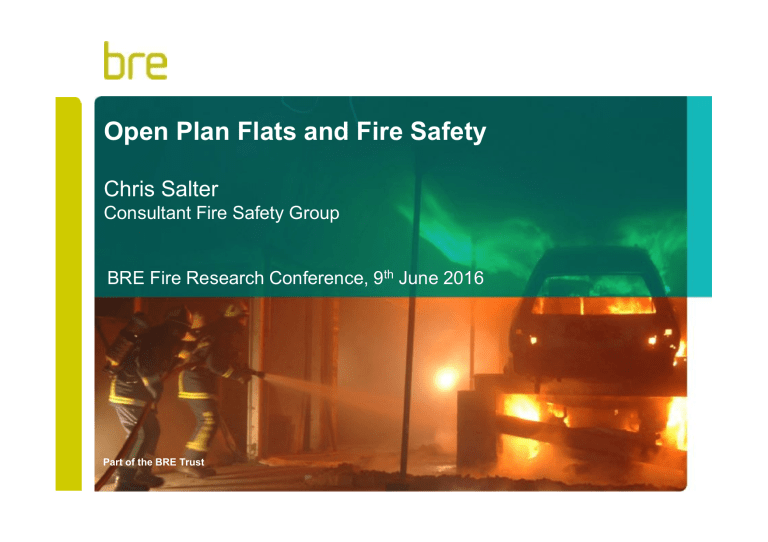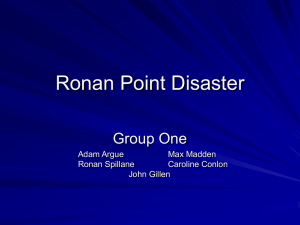Open-plan flats and fire safety - Dr Chris Salter

Open Plan Flats and Fire Safety
Chris Salter
Consultant Fire Safety Group
BRE Fire Research Conference, 9 th June 2016
Part of the BRE Trust
Open Plan Flats – What, Why, How?
– What is an open plan flat?
– Why do people want them?
– How do we achieve them?
– Are they safe?
Open Plan
– Open plan flats can be considered to be flats that do not contain a protected entrance hall
– Escape from a flat is via an accommodation room – such as the living room
Why Open Plan?
– The market wants open plan flats
– Buyers
– Architects
– Investors
– Maximise the use of space within flats
– American flats have been open plan for many years
UK Building Regulations
– We build to meet the functional requirements of the Building
Regulations 2010.
UK Building Regulations
– We build to meet the functional requirements of the Building
Regulations 2010.
– Approved Documents
UK Building Regulations
– We build to meet the functional requirements of the Building
Regulations 2010.
– Approved Documents
– BS 9991 – Fire Safety in the
Design, Management and Use of
Residential Buildings
Approved Document B:
Volume 2
– Covers the design of flats
– Requires a 9m protected entrance hall
Approved Document B:
Volume 2
– Covers the design of flats
– Requires a 9m protected entrance hall
– OR
– 9m internal travel distance to furthest point
Approved Document B:
Volume 2
– Covers the design of flats
– Requires a 9m protected entrance hall
– OR
– 9m internal travel distance to furthest point
– OR
– Alternative means of escape from the part containing bedrooms
BS 9991
– Allows open plan flats
– Based on NHBC “ Open plan flat layouts: Assessing life safety in the event of a fire” – Research conducted by
BRE.
BS 9991
– Requires LD1 alarm system
– Automatic water fire suppression system
– No greater than 16m x12m
– Single level
– Enclosed kitchen after flat exceeds 8m x 4m
– Minimum ceiling height
BS 9991
– Allows open plan flats
– Based on NHBC “ Open plan flat layouts: Assessing life safety in the event of a fire” – Research conducted by
BRE.
– Restricted to values within the research
– NHBC document states that this was purely the results that were studied due to cost
Current Position
– Therefore, open plan flats are currently considered to meet the Building Regulations when they comply to BS
9991.
– However, is this considered to be far reaching enough?
– What about
– Larger open plan flats?
– Multi level flats?
Fire Engineering
– Fire engineering solution required to justify deviations from the guidance in BS 9991
– Often requires “evidence” that a solution will provide the same level of safety as a code compliant solution
– Modelling of the proposed layouts are usually produced
Modelling
– Comparative approach
– Deterministic approach
Comparative Approach
– Compare the proposed solution to a code compliant
ADB or BS 9991 solution
– Proposed should demonstrate conditions that are no worse than a compliant solution
Deterministic Approach
– Demonstrate conditions within the flat, using a worse case scenario, as discussed with Building Control
– Up to discussions with the Approving Authorities as to what method should be used
Computer Modelling
– Usual method would be to use Fire Dynamics
Simulator
– Tried and tested. Extensive validation
– Outputs are left to end user and Approving Authority to graph and interpret
FDS Model
Computer Modelling
– BRE also make use of in house software, CRISP
• C omputation of R isk I ndices by S imulation P rocedures
– Provides probabilities of risk, rather than estimated internal conditions
– CRISP was used for the NHBC research that forms BS
9991
CRISP
– Takes into account random variables
• Fire type and location
• Door and window status
• Glass breakage
• Human decisions
– Can run more scenarios within a given time than FDS
– Output = Risk of death - pr(FED > 1.0)
CRISP
Are they safe?
– Generally speaking, it appears the addition of sprinklers makes the design as safe, if not safer, than an ADB compliant flat
– Open plan appears to be no worse than leaving flat doors open in an ADB compliant solution
• Previous BRE study shows that protected entrance hall doors are left open 60% of the time
Are they safe?
– Other mitigation measures may be required – such as ventilation
– However, solutions require occupants to keep the items maintained
– Yet, a smoke detector will not help if not maintained either
Thoughts
– “We” have decided that new builds require alarms, but there is no requirement to maintain them
– Do “we” therefore make the same decisions in regard to the protected entrance hall and sprinkler systems?
– After all, occupants can remove these once they own the property
Conclusions
– Open plan flats can be built to BS 9991 or by using a fire engineered justification
– The justification is likely to be either a comparative or deterministic assessment (occasionally a hybrid of the two)
– BRE have carried out research into open plan layouts and show that these can be equivalent to an ADB compliant solution
Key Points
– Layout requires a BS 9251 compliant sprinkler system throughout the flat
– Flats larger than 12m x 16m or multi level require a fire engineered justification
– All of this should be discussed with the Approving
Authorities at an early design stage
Thank you
Chris Salter
Fire Safety Scientist, Fire Safety Group
T: +44 (0) 1923 664922
E: salterc@bre.co.uk
W: www.bre.co.uk/fire
BRE, Garston, Watford WD25 9XX, UK




